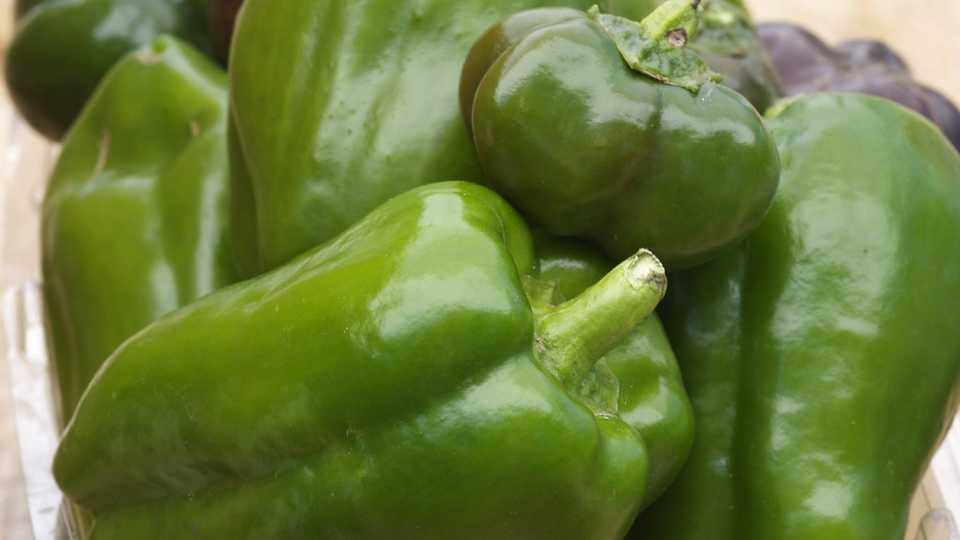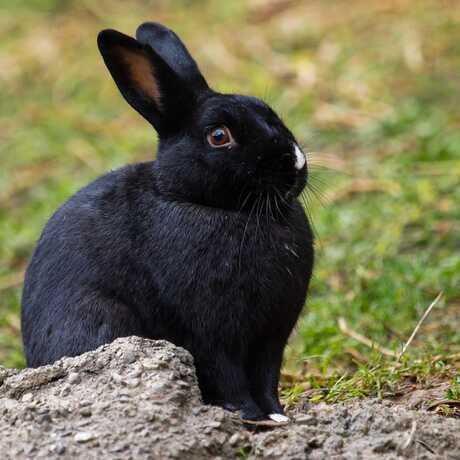
This activity uses green peppers to provide a concrete example of high reproductive potential. This sets the stage for understanding the “struggle for existence” concept that was proposed by Malthus and that influenced both Darwin and Wallace in developing their ideas about evolution.
In this activity, students will:
- learn that organisms produce more offspring than the environment can support.
- understand how this concept influenced Darwin in his development of the theory of evolution by natural selection.
- green peppers (1 per group of 3 or 4 students; do NOT use hot peppers)
- gloves (for protecting sensitive skin)
- scissors or knife to cut open the peppers
- plates or napkins
- worksheet (1 per group)
- fertility: the ability to produce viable offspring
- fitness: the ability of an organism to survive and produce viable offspring in a particular environment; or the reproductive success of an organism in a particular environment
- natural selection: the process by which organisms with higher fitness survive and reproduce at a higher rate than those with lower fitness, resulting in the survivors’ characteristics being more prevalent in subsequent generations. Originally proposed by Charles Darwin, natural selection forms the basis of the process of evolution.
- Purchase sweet green peppers, one for every 3 or 4 students. Green peppers have lots of seeds, so counting will be easier in groups. DO NOT USE HOT PEPPERS!
- Make copies of the “Knee-Deep in Green Peppers” worksheet for each group.
- Have scissors or knives available to cut open the pepper and plates or napkins to count the seeds on.
- Some teachers have reported skin irritation from handling peppers, so rubber or latex gloves are advised.
Show the students a single green pepper. Ask them to predict what the green pepper population size could be after four generations if they start with only one green pepper in the first generation and each of the seeds produced a viable pepper plant.
- Divide students into groups of 3 or 4.
- Give each group a worksheet, a green pepper, scissors or a knife, and a plate or napkin.
- Tell the students to cut the pepper open carefully and count all the seeds. When they finish counting, have them answer all the questions on the worksheet.
As you reflect on the experience, consider the following:
- Were you surprised by the potential population size that you calculated? Why is it so surprising?
Since we never see such huge populations of green peppers, it seems strange to think that they are theoretically capable of producing so many offspring.
- If a single green pepper can produce such a large population, why are we not “knee-deep in green peppers”? Why do we not see huge populations of them covering the planet?
It’s not possible for all of the seeds produced to grow into successful plants—there are not enough resources to support such large populations and many other factors such as predation, disease, and environmental fluctuations can limit population size. Some seeds won’t germinate. Of those that do germinate, some won’t survive to reproductive age. Of those that do survive, some won’t be able to reproduce.
- Did all of the green peppers contain the same number of seeds? Why might this variation be important?
There will be some variation in the number of seeds produced. Differences in fertility are important for natural selection—individuals that can produce more offspring will have a greater contribution to the gene pool of the next generation (i.e. greater fitness). Keep in mind, however, that differences in fertility only matter if the individual can survive long enough to actually reproduce.
- What other types of variation might be important in determining which green peppers will survive and reproduce?
Brainstorm ideas that might give a green pepper plant an advantage, such as faster growth rate, more efficient water use than other pepper plants, stronger stems, etc.
Reinforce the concept that many organisms are able to produce more offspring than the environment can support. Explain that this idea was key in helping Darwin and Wallace work out their models of natural selection (reference the Educator Background section for an explanation).
This discussion can provide a good segue into activities (such as Candy Bowl Predation or Breeding Bunnies) that focus on the importance of variation in natural selection.
Charles Darwin and Alfred Russel Wallace independently developed theories of natural selection in the 1800s. They were each influenced in their thinking by a variety of different experiences, readings, and observations. On one point, however, they both drew inspiration from the same source: the 1798 writings of political economist Thomas Malthus.
In An Essay on the Principle of Population, Malthus observed that the human population was capable of growing faster than our food supply could be increased. He pointed out that if human population growth were uncontrolled, our population would inevitably outgrow our food supply, leading to famine and general misery. The reason this had not already occurred was that population growth was slowed by forces such as disease and war.
While Malthus was concerned with the social impacts of this situation, Darwin and Wallace each realized that the simple fact that every population, human or otherwise, has the capacity to outgrow its resources if left unchecked has important implications for evolutionary theory.
In On the Origin of Species, Darwin makes the following calculation: “There is no exception to the rule that every organic being naturally increase at so high a rate that, if not destroyed, the earth would soon be covered by the progeny of a single pair .... The elephant is reckoned the slowest breeder of all known animals, and I have taken some pains to estimate its probable minimum rate of natural increase; it will be safest to assume that it begins breeding when thirty years old, and goes on breeding till ninety years old, bringing forth six young in the interval, and surviving till one hundred years old; if this be so, after a period of from 740 to 750 years there would be nearly nineteen million elephants alive, descended from the first pair.”
This brings up an obvious question: why is the Earth not covered in millions and millions of elephants? The answer may also seem obvious: because not every elephant can survive. There are not enough resources to support such a large population—not enough food, not enough fresh water, and not enough space. Competition for those resources as well as predation, disease, and a variety of other factors act as checks on population growth.
As Darwin and Wallace realized, the question of why the Earth is not covered in elephants is not the important point. The less obvious—and far more interesting—question is what determines which elephants will survive?
In his autobiography, Charles Darwin wrote: "In October 1838, that is, fifteen months after I had begun my systematic inquiry, I happened to read for amusement Malthus on Population, and being well prepared to appreciate the struggle for existence which everywhere goes on from long- continued observation of the habits of animals and plants, it at once struck me that under these circumstances favourable variations would tend to be preserved, and unfavourable ones to be destroyed. The results of this would be the formation of a new species. Here, then I had at last got a theory by which to work".
As other activities in this curriculum highlight, a remarkable degree of variation exists among individuals of a single species. While many differences have little or no effect on an organism’s success, differences in some traits can greatly affect an individual’s fitness. Fitness is the reproductive success of an organism. An individual with higher fitness produces more viable offspring (therefore passing on a higher proportion of genes to the next generation) than an individual with lower fitness. The traits of individuals with higher fitness become more and more common as generations go by, while the traits of individuals with lower fitness may eventually be lost from the population. This is the process that Darwin called natural selection.
In order for natural selection to occur, there must be variation among individuals and a “struggle for existence” in which not all individuals can survive. Without variation, there would be no differences in fitness. Without a Malthusian “struggle for existence,” differences in fitness wouldn’t matter. All individuals would be able to survive and pass on their genes, and the population would look the more or less the same from one generation to the next. As Darwin realized, natural selection is an unavoidable consequence of the existence of variation and the fact that more offspring are produced than can possibly survive.
This activity uses green peppers to provide a concrete example of high reproductive potential. This sets the stage for understanding the “struggle for existence” concept that was proposed by Malthus and that influenced both Darwin and Wallace in developing their ideas about evolution.
This activity could serve as part of a much larger unit that aims to address the below standards.
Related Performance Expectations
Remember, performance expectations are not a set of instructional or assessment tasks. They are statements of what students should be able to do after instruction. This activity or unit is just one of many that could help prepare your students to perform the following hypothetical tasks that demonstrate their understanding:
MS-LS4-6.Use mathematical representations to support explanations of how natural selection may lead to increases and decreases of specific traits in populations over time. [Clarification Statement: Emphasis is on using mathematical models, probability statements, and proportional reasoning to support explanations of trends in changes to populations over time.] [Assessment Boundary: Assessment does not include Hardy Weinberg calculations.]
Science and Engineering Practices
This activity addresses Using Mathematics and Computational Thinking in that is a straightforward calculation that uses geometric growth to illustrate how quickly a species can multiply given unconstrained reproduction.
6-8: Use mathematical representations to support scientific conclusions and design solutions.
Darwin, Charles. (1872). On the origin of species by means of natural selection, or the preservation of favoured races in the struggle for life (6th ed.) London: John Murray.


